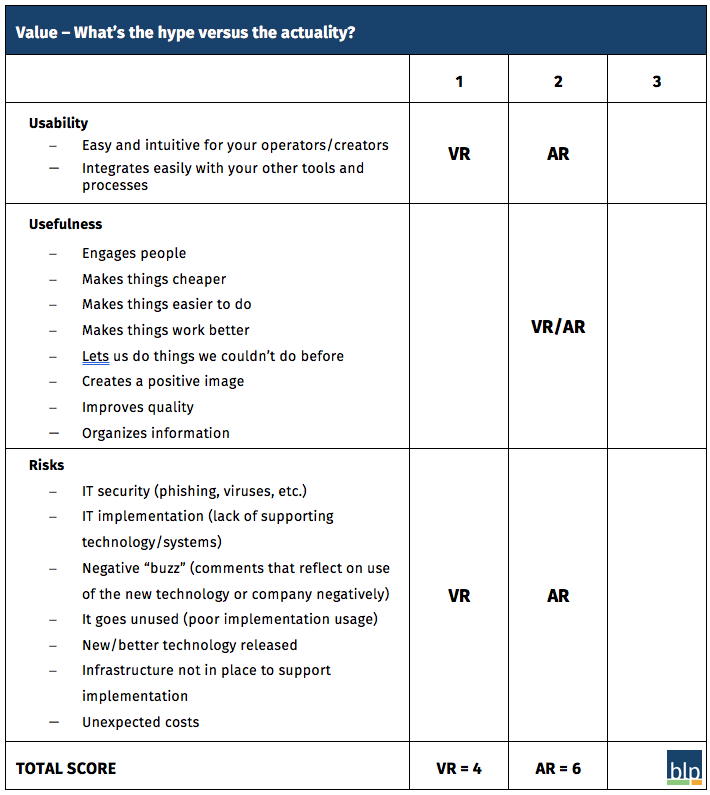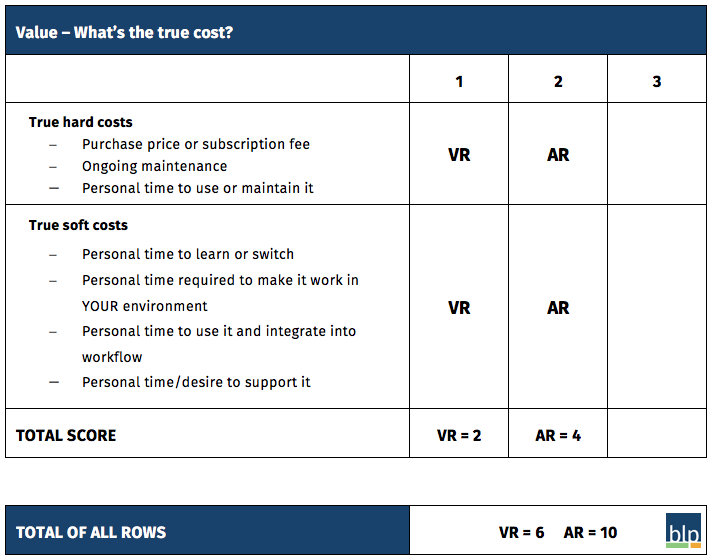Lots of L&D professionals are excited about Augmented Reality (AR) and Virtual Reality (VR), and for good reason. There’s reason to believe that these technologies will be useful for a wide range of training needs in the years to come. VR/AR was the most frequently mentioned trend by survey respondents in our 2018 Learning Trends Report. But is the technology there yet? Should you rush out and plan a pilot program? For most organizations, the answer is probably “not yet, but wait and watch.”
Defining the Technology
Virtual reality is getting the most buzz at the moment. VR uses headsets, sometimes in combination with physical spaces or multi-projected environments to generate a completely artificial environment into which a user can become completely immersed. It often uses other inputs such as wands to allow for interaction through simulated touch or tool use. Two commercially available platforms are HTC’s Vive and PlayStation VR.
Augmented reality refers to the integration of digital information with a user’s real environment. Unlike VR, which creates a completely artificial environment, AR uses the existing environment and overlays digital information on top of it. AR can be achieved via commonly available devices such as smartphones and the Nintendo 3DS.
Exploring What’s Possible
Over the past year, Bottom-Line Performance has had internal discussions about the impact that VR and AR could have on learning solutions we develop for our clients. Last summer, we held an exploration day at BLP to give all BLP employees a chance to experiment with the technology and get a baseline understanding of what it is and how it works.
More recently, many of us visited VisionThree, a local VR development studio. VisionThree demonstrated multiple examples of their work that included mostly convention booth focused apps that showed what’s possible with this technology.
Our impressions from these experiences, combined with our ongoing industry research and benchmarking efforts, helped us draw our conclusion as to the best approach for VR and AR in 2018. We also used our Learning Technology Evaluation Checklist to objectively evaluate their pros and cons.
The Highlights
Before you see how we scored VR and AR on our technology checklist, I want to provide you with a high-level overview of the strengths and weaknesses of VR and AR.
Virtual Reality’s Strengths
Here’s what makes virtual reality so appealing:
- Immersive experience – VR allows you to step into a whole different world. It provides a cool first impression and a unique learning experience compared to a typical eLearning course.
- Emotional connection – VR can trigger emotional reactions that your learners may actually encounter on-the-job such as fear, anger, anxiety, stress. You can use it to let learners analyze their reactions and develop strategies for managing or minimizing those reactions.
- Muscle memory – Things like muscle memory and spatial recognition only seem possible with VR.
- Safe environment – VR provides a safe space to practice skills that are risky to learn on the job (e.g. flying a jet, performing surgery, putting out a fire).
Virtual Reality’s Challenges
Even in situations where the use case for VR is strong, these hurdles must be addressed:
- Hardware requirements – Right now, users have to be tethered to a computer, which puts some constraint on where you conduct training.
- Nausea factor – The high incidence of nausea means that the duration of most VR experiences must be limited (10-15 minutes seemed to be tolerable for our team.) A few of our experienced VR users did say that motion sickness becomes less pronounced if you gradually increase your exposure over time, but most training situations won’t allow this.
- Integration and implementation issues – VR may not integrate easily with the infrastructure already in place at your organization making implementation more difficult.
- Development and maintenance expenses – Right now, VR is expensive to produce and maintain. It requires 3D art, skilled programmers, and specific tools that aren’t in the “rapid authoring tools” category.
Augmented Reality’s Strengths
- Development time – AR technology is attainable in a relatively short amount of time.
- Low cost – AR costs very little compared to most VR technologies.
- Availability – Almost every learner already has a AR compatible device (smartphone) in their pocket.
- Fosters community – VR can feel isolating, whereas AR allows you to play and interact simultaneously with others, which can foster community and deepen knowledge.
Augmented Reality’s Challenges
The only weakness we could identify for AR is limited use cases. It’s not always easy to identify specific training situations where AR might be appropriate.
See how other L&D pros plan to deliver training this year in our 2018 Learning Trends Report.
The Learning Technology Evaluation Checklist
BLP created the Learning Technology Evaluation Checklist to help our company make smarter technology adoption decisions. We needed a way to objectively evaluate technologies and separate the good from the bad. We use the checklist below to evaluate virtual and augmented reality for workplace learning. The checklist can help quantify each technology’s functionality, costs, risks, gains, and more.
Functionality – What does the technology help you and your learners do?
Both VR and AR can help you:
- Create (improve method of authoring learning materials)
- Assess (identify learner strengths and weaknesses through analytics)
- Collaborate (provide methods for co-creation)
VR and AR can help your learners:
- Engage (motivate and inspire in a new way)
- Retain (commit information to long-term memory)
- Practice (build proficiency in a skill)
- Assess (prove proficiency)
In terms of functionality, AR has a few additional perks compared to VR. AR allows you to integrate or link different tools and/or data and pulls two different perspectives together. This technology also has an additional function for learners: find and locate. AR can help learners access training content at the moment of need.
Value – What’s the hype versus the actuality?
We used the technology checklist to grade VR and AR in each category in the chart below. We gave each technology a 1, 2, or 3 points based on the following definitions:
- “The learning technology is likely to create an undesirable outcome.”
- “The learning technology is likely to create an acceptable outcome.”
- “The learning technology is likely to create a very desirable outcome.”
Value – What’s the true cost?
We then used the checklist to grade VR and AR in each cost category. We gave each technology a 1, 2, or 3 points based on the following definitions:
- “The learning technology’s cost is likely higher than our acceptable level.”
- “The learning technology’s cost is likely at our acceptable level.”
- “The learning technology’s cost is likely lower than our acceptable level.”
Interpreting Each Score
5 – 7 The learning technology is likely not desirable at this time for our organization.
8 – 10 The learning technology may be optimal for our organization.
11 – 13 The learning technology is likely optimal for our organization.
14 – 15 The learning technology is likely a critical area of need for our organization.
As you can see, virtual reality did not receive very high score on our checklist. We simply don’t see many of our clients having a specific need for VR (yet). Augmented reality scored in the “May be Optimal” range because the costs and technology needs are more attainable.
Of course, our scoring of these technologies is subjective. If you worked through the technology checklist and considered your own needs, your scores may come out differently. For example, if your employees must learn how to use a piece of equipment that costs tens of millions of dollars, a VR solution that allows them to practice in a safe environment is a reasonable investment and will likely score higher.
We do think VR and AR are technologies to watch. If equipment and development costs begin to fall, they could become viable quickly.














